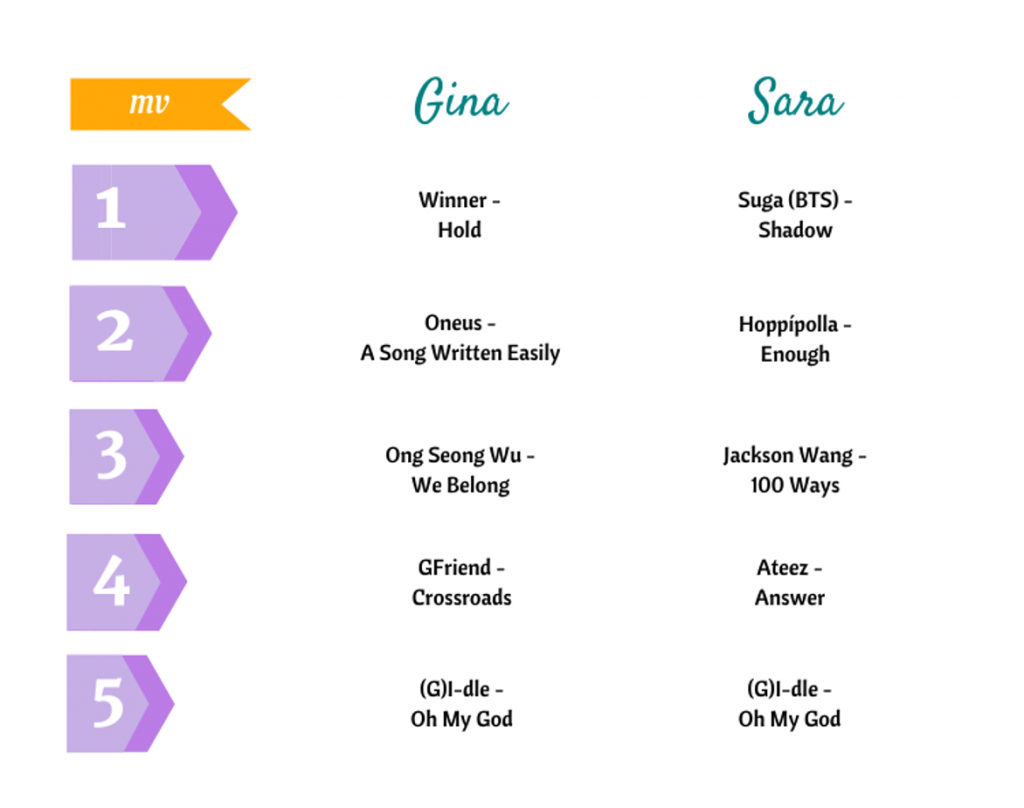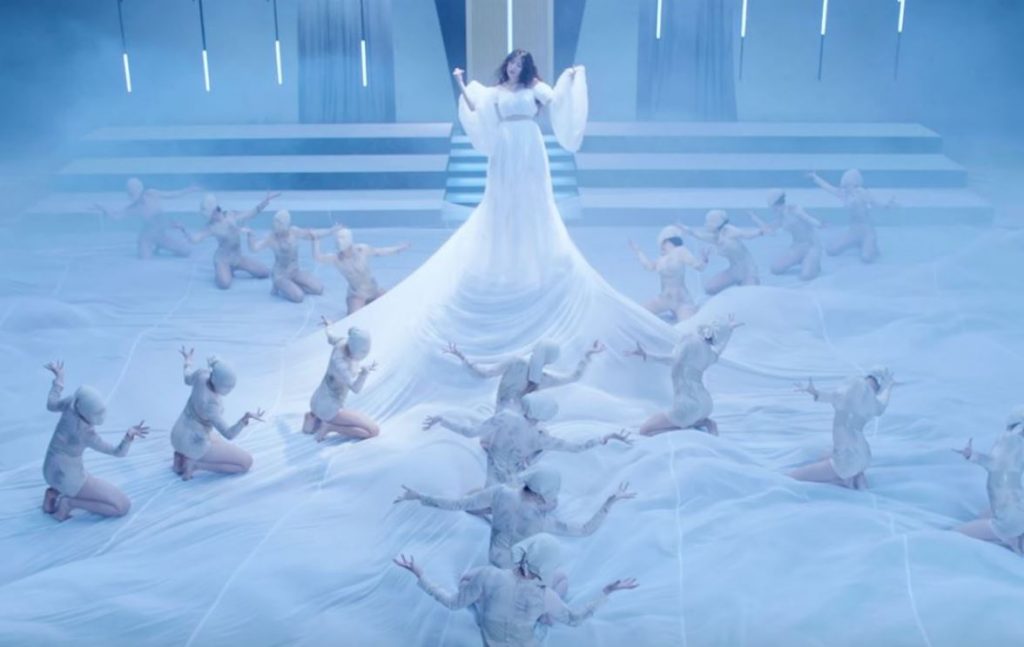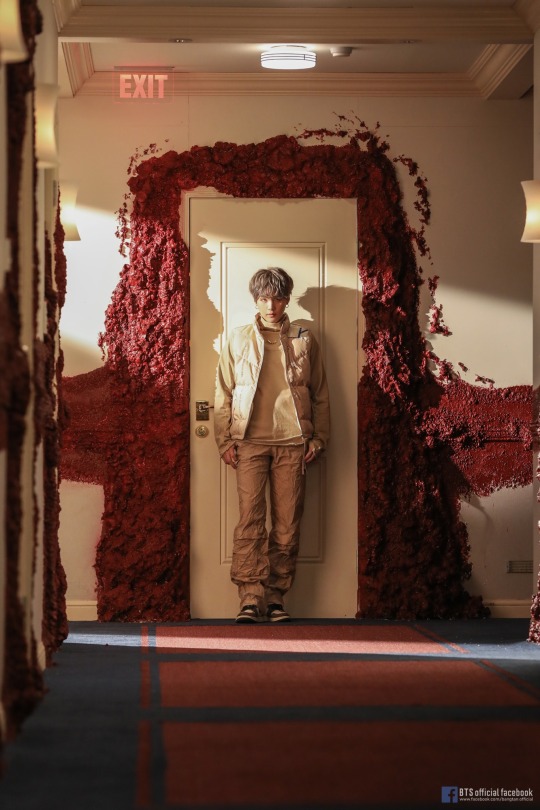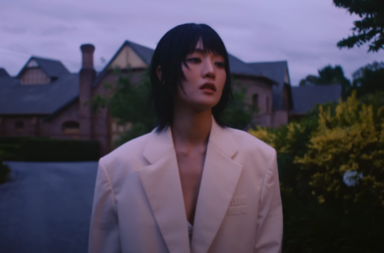Looking back at the year’s releases so far, Gina and Sara touch on MV’s that distinctively highlights the artists in new and improved ways. Most of the categories have come down to narrative versus aesthetic, as MV directors churned out fresh ideas to keep this year interesting. Although last year’s Mid-year Review revealed a focus on cinematography, aesthetics, and a need for artistry, 2020 reveals a creative sense on plot and visual execution.

Sara: 2020 has been such a whirlwind of a year, so it was honestly a bit challenging to remember which music videos were actually released in the past six months. But to start off the discussion, let’s talk about the MV we both chose: “Oh my god” by (G)I-dle. What made you pick this MV, and what were your reasons behind placing it in the fifth spot?
Gina: I agree with you Sara, I’ve also had to retrace which comebacks occurred so far. For me, the group’s daring portrayal of darkness kept my attention. Everything from the stark contrast in colors to the mystical, haunting elements left me amazed long after it was over. Not many girl groups can say they’ve achieved a creepy (even gory?) concept that isn’t utilized just to impress — it was for the sake of portraying their song in the most accurate, spellbinding way. None of the members held back in embracing this dark approach, which helps achieve its desired effect.
I also think it helps that (G)I-dle consistently tackles fresh ideas that steers away from previous ones. To a certain extent, we knew we should anticipate something very different — but they don’t disappoint in mastering what they dare to try. What was the factor that made you choose this MV, Sara?
Sara: It was definitely the dark element for me, as you mentioned, because I am especially drawn to storylines that uncover a darkness. “Oh my god” has its bright moments, such as the set that opens the MV, but it is a stark and chilling white room. When paired with the ominous church bells and falling wine glasses full of blood, the visuals of the story captivates the viewers.

And the sets! They are stripped down spaces, but the people and their movements/expressions create tension that had not existed beforehand. When I say this, I think of the set with the purple lighting. We follow that member’s movements with the scarf (the only color besides the walls), since her space is the brightest, as the light shines only on her. We are so captivated by her that we push the back-up dancers to the corner of our minds, yet they are intriguing because they have cloth over their faces and, thus, cannot see. What are we ignoring when we set all of our attention solely on the light?
Gina: I agree! Everything contributes to the atmosphere that we see, like a complete package. Going off of what you said about the lighting, it has us see a new aspect of the performance with every replay. Depending on where we look, our interpretation of their concept can evolve every time.
I think another MV you chose that finds its strength in its setting is Suga’s “Shadow.” Suga stood out so vividly from every scene, and it was particularly powerful to make Suga’s face the only one we actually get to see. It was a compelling, disturbing contrast, but one that speaks volumes about the relationship between a celebrity and the public. The lack of an identifiable face, but instead a focus on aspects such as reaching hands or phone screens silently reflect the depth behind his lyrics, making the whole comeback all the more relevant. What are your thoughts on it, Sara?
Sara: As you can see, I chose Suga’s “Shadow” as my favorite MV of 2020 (so far). I think “Shadow” is a masterful piece of art. The MV has about four different sets, but the narrative is so cohesive through them all that the MV is deceptively simple. This, in fact, increases its complexity because each set, each of Suga’s expressions, and every line of his rap encourages viewers to dig deeper into their own perceptions of the stars that they love.

Being the art history nerd that I am, I personally loved the art that was incorporated into this MV, particularly the set that was inspired by Anish Kapoor, an Indian artist, and his work titled “Svayambh” (Sanskrit for “self-made”). The piece is a part of the opening set of “Shadow” with the red wax that outlines the doorway that Suga stands in front of. When this version of “Svayambh” is interpreted with a context like “Shadow,” its usage prompts so many thoughts. We see Suga standing in front of that doorway—how much did he have to sacrifice to get to where he is now as a member of BTS? How much of himself was shaved away in that process, regardless of what he has gained? The original “Svayambh” strikes me as such a violent piece of art, and that element of subtle violence definitely carries into Suga’s “Shadow.” It is fascinating to dive deeper into how every element of this MV, including Suga’s lyrics, come together to create such a compelling narrative.
“Hold” by Winner is your top MV of 2020. What makes it your favorite?
Gina: For me, “Hold” is my top favorite because of its refreshing, comedic aspect. Winner goes all out in not only being so relatable in their roles as overprotective brothers, but also not caring about how hilarious they’re being. The first time I watched it, I remember laughing and wondering if they’re the same idol group that portrayed such heavy, dark emotions in their previous MV for “SOSO.” The MV could’ve been a sitcom if it were longer, with its comedy and realism keeping its quality solid. Moreover, the ending where the four “brothers” spoil Suhyun’s first kiss is juxtaposed with a cheesy dance break, where Winner literally makes a fool of themselves. Once the MV is over, we can sympathize with Soohyun but also applaud the four members, just like the BGM does.
Other MV’s you listed that are akin to actual films are Hoppípolla’s “Enough” and Jackson Wang’s “100 Ways.” Both were pleasant (and bittersweet) surprises from start to finish. Could you expand more on what made these MV’s stick out?
Sara: Hoppípolla’s “Enough” and Jackson Wang’s “100 Ways” are evidence of my love for narrative MVs, especially dark and sad stories. I listened to “Enough” before I saw its MV, but the song already has so much emotion poured into the way the instruments are played and each line the vocalists sing that it translates beautifully as a MV. Unlike “Oh my god” and “Shadow,” Hoppípolla’s MV is mainly set against a natural landscape (the lake is gorgeous but haunting) with shots of the band dispersed between the story. The MV holds your attention with its simple but complex narrative and beautiful cinematography. In the case of “Enough,” the song almost becomes the soundtrack of the MV. However, “Enough” only adds to the swelling emotions and the sense of urgency of the story, particularly during the height of the song, which is the last chorus.
For similar reasons, “100 Ways” stuck with me. The simple narrative—the main character finding his lover again—is spellbinding in the fact that the characters were raised from the dead. The story focuses on the mysterious and fog-covered wood as its one location, which adds to the tight composition of the MV. Jackson Wang’s choreography also does not feel out of place because he uses sharp movements that match the sharpness of the beat to add to the story, such as when his guards put his armor on before searching for his lover. “100 Ways,” as a body of work, felt so cohesive, and the unexpected narrative captivates its viewers. It is one of those songs that I believe are strengthened when one sees the MV.
GFriend’s “Crossroads” MV also has a more narrative style. What made you choose this MV?
Gina: Your explanation for both “Enough” and “100 Ways” are spot on. For me, the former track was truly intense, with the tension behind the song and MV heightening up to its heartbreaking climax. The MV successfully portrayed the delicate balance that a bittersweet mood requires, with the innocent interactions between the male and female roles hinting towards something more ominous. For “100 Ways,” it was a beautiful blend of storytelling, culture, and creativity. Having Jackson solely in that scenery, as he sings, dances, and keeps the plot going was a refreshing way to present a specific love story.
On that note, GFriend’s “Crossroads” made it to my list due to its raw, emotional atmosphere. While most of GFriend’s MV’s have a slightly mystical, innocent, and very homey vibe, “Crossroads” in particular seemed more human. Portraying just the girls, each member has a conflict with another that does a great job portraying realistic relational pains. This is achieved through a close focus on these very conflicts, without any frills or special effects attached. While the butterfly in the beginning is fantastical, the rest of the story doesn’t hesitate in revealing upset face expressions or chaotic fights, prior to showing reconciliation. Each member adds to the visual realism by portraying their own inner struggle, making this MV relatable for its audience. While the track is about love, the MV takes the chance to show what we can experience while in the middle of a crossroad intersection for any kind of relationship.
With narrative MV’s completed, let’s move onto more stand-out, colorful MV’s. What caught your eye with Ateez’s “Answer”?
Sara: “Answer” is a good transition for our discussion because the MV does have a bit of a narrative to it, but at first glance, it definitely stands out for its sets and its colors. Ateez’s “Answer” is a culmination of their story as a group up until this point rather than focusing on a fictional story. Maybe the “answer” they have found is that Ateez has found their footing as artists and have developed immensely since the release of “Pirate King”—it is hard to believe that they still can be considered rookies. A key moment in the “Answer” MV is the scene where Ateez sits at the long table in the mansion across from their “Say My Name” personalities. “Answer” provides the moment for the past and present to meet: the members do not directly interact with their past selves but rather seem to be studying them. They reflect on how they have changed since their beginning.
Now, Ateez is moving forward. While movement is naturally present in their choreography, there are other elements that add to this subtle idea. A hand touching the still surface of the water creates ripples, the colorfully patterned fabric surge in the background of Ateez’s choreography scenes, and the variation in light causes the highlights and shadows to dance across each member and space.
On that note, light and color are also important in your last two favorite MVs, Ong Seong Wu’s “We Belong” and Oneus’s “A Song Written Easily.” What drew your attention to these MVs?
Gina: Personally, Oneus has been a growing favorite due to their high quality concepts, and MV’s. For this comeback, not only were the song and instrumental a fresh way to approach the common theme of a breakup, but the MV lent itself to be the crowning winner in their discography. “A Song Written Easily” is similar with “Twilight,” in that the scenery matches the mood they are seeking to achieve. For instance, the faraway landscape shots can refer to the distance that Oneus feels from their lover, which can only be crossed by memories or dreams. Meanwhile, close shots are usually filmed without direct eye contact — proving that despite the scenery, they only see a particular memory in their heads. What else is noteworthy is the MV’s aesthetic, balanced color palette. The vivid colors and tones work to reveal multiple ways this song can be interpreted throughout the MV.
Ong Seong Wu’s MV is another great example of visual cohesion, although the entire set is filmed indoors. There’s plenty of creative control that the directors exerted within the confined space, and the result is many refreshing ways to enjoy our eye candy. I particularly loved how, despite the simple idea of having Ong communicate his real feelings towards a girl, each set portrayed this idea in a new light. From color coding to fully incorporating the space available, the MV neither felt superficial nor crowded, but rather very intentional. Everything worked to highlight Ong as he sang and acted, and he blended in perfectly with the strong use of matching colors and tones. While indoor MV’s can be a hit or miss based on how “staged” it might feel, this work was successful in its visual appeal.
All things considered, the first half of the year included plenty of variety with how MV’s were executed. With another six months left to go, it’s exciting to see what types of MV’s will catch our eye in time for the end-of-the-year reviews. In the meantime, let us know in the comments if you agree with the writers, or have another contender in mind!
(YouTube [1] [2] [3] [4] [5] [6] [7] [8] [9]; Images via Bighit Entertainment & Cube Entertainment)



